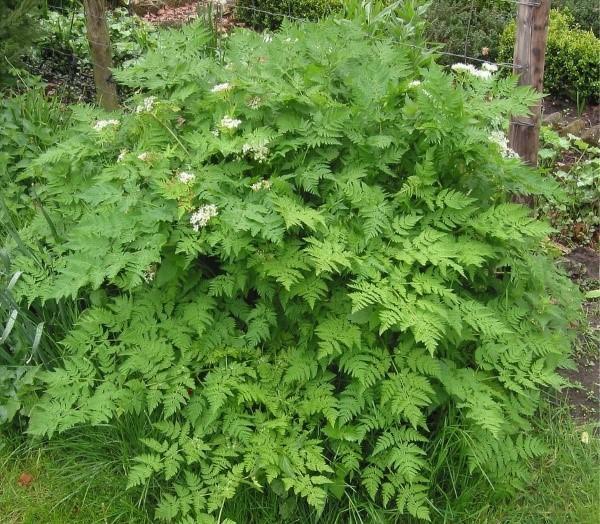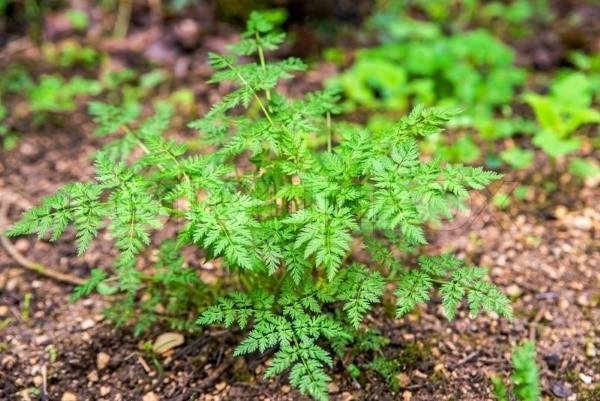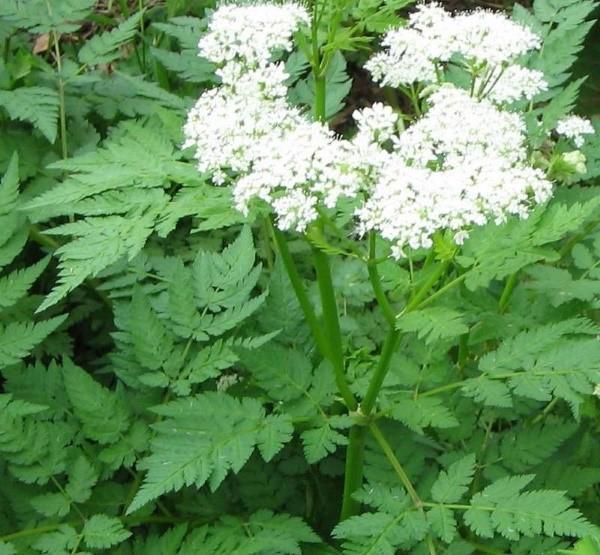We master the cultivation of chervil - a fragrant and unpretentious spice
 Among gardeners, lovers of spicy herbs, you can often find lush chervil bushes among the beds with dill and parsley. Why not, because growing chervil is a simple and not troublesome procedure. Fragrant bushes from early spring to late autumn will produce spicy greens. In addition, they are not whimsical at all, since they can grow even in the shade of trees, and are not afraid of low temperatures. If you decide to add this plant to your green beds, we suggest using our recommendations. By following them, you will provide households with useful vitamins and minerals. There are so many of them in green fragrant twigs that chervil is successfully used both in cooking and in folk medicine.
Among gardeners, lovers of spicy herbs, you can often find lush chervil bushes among the beds with dill and parsley. Why not, because growing chervil is a simple and not troublesome procedure. Fragrant bushes from early spring to late autumn will produce spicy greens. In addition, they are not whimsical at all, since they can grow even in the shade of trees, and are not afraid of low temperatures. If you decide to add this plant to your green beds, we suggest using our recommendations. By following them, you will provide households with useful vitamins and minerals. There are so many of them in green fragrant twigs that chervil is successfully used both in cooking and in folk medicine.
Foreign parsley or who is chervil

 Depending on the time of sowing, from late spring to late summer, chervil blooms, revealing umbellate inflorescences of small white flowers. By autumn, small black seeds ripen in their place. Ripening lasts unevenly, therefore, if they are not removed in time, chervil is sown by self-seeding.
Depending on the time of sowing, from late spring to late summer, chervil blooms, revealing umbellate inflorescences of small white flowers. By autumn, small black seeds ripen in their place. Ripening lasts unevenly, therefore, if they are not removed in time, chervil is sown by self-seeding.
Chervil has many names: kupyr, corvel, karefi, cerfolio. It is also known as French parsley for being an indispensable ingredient in French cuisine, in particular for the national soup.
 There are several varieties of chervil, most of which are designed for cutting fragrant greens with an original and complex combination of anise flavors, parsley and fennel. Among them, the most popular are such types of chervil, which differ in the shape of the leaves:
There are several varieties of chervil, most of which are designed for cutting fragrant greens with an original and complex combination of anise flavors, parsley and fennel. Among them, the most popular are such types of chervil, which differ in the shape of the leaves:
- simple smooth-leaved;
- curly;
- double curly.
But there are also tuberous varieties: they form a long root vegetable with an edible sweet and juicy pulp. It looks like a parsnip or white carrot in appearance and is good in salads.
Due to its ability to reproduce by self-seeding, chervil is grown as an annual. In controlled cultivation, seeds are sown directly into open ground. They sprout well, and the bushes can withstand even 12 ° C of frost, so there is no need to tinker with seedlings. The spicy foliage is harvested in waves, cutting off about every two weeks.
Let's take a closer look at when, where and how to grow chervil from seeds, as well as basic plant care activities.
When to sow seeds for fresh greens until late fall
 The growing season for chervil lasts up to 50 days, after this time the bushes begin to fade gradually. In order to have fresh greens on the garden all season, it is better to sow in three approaches:
The growing season for chervil lasts up to 50 days, after this time the bushes begin to fade gradually. In order to have fresh greens on the garden all season, it is better to sow in three approaches:
- Early spring (March-April, depending on the region of cultivation).
- Midsummer (late June - early July).
- Late summer - early fall (August-September).
Chervil feels great at home. To have a spice in winter, it can be grown as a pot plant on a windowsill.
 It is noteworthy that podzimny chervil sowings leave for the winter green, but in early spring they will give fragrant leaves. If you decide to control reproduction and collect your seeds, you can do this on bushes planted in early spring or before winter. In the first case, they will bloom already in the current season, in the summer, and in the second, only next spring, in April. This means that the seeds will ripen only by next summer, and this should be taken into account when stocking up on our own planting material.
It is noteworthy that podzimny chervil sowings leave for the winter green, but in early spring they will give fragrant leaves. If you decide to control reproduction and collect your seeds, you can do this on bushes planted in early spring or before winter. In the first case, they will bloom already in the current season, in the summer, and in the second, only next spring, in April. This means that the seeds will ripen only by next summer, and this should be taken into account when stocking up on our own planting material.
Spring chervil (meaning sowing dates) is usually more compact, up to 35 cm in height. Whereas, as a result of autumn sowing, impressive bushes with a height of about 70 cm grow.
Where chervil will grow
 As already mentioned, this culture is absolutely not demanding on lighting. If there is no free space in the garden, you can sow chervil in the garden under the trees. There he will also grow deciduous mass. True, in a sunny area it will be more lush and dense, but, as an option, a garden is also suitable.
As already mentioned, this culture is absolutely not demanding on lighting. If there is no free space in the garden, you can sow chervil in the garden under the trees. There he will also grow deciduous mass. True, in a sunny area it will be more lush and dense, but, as an option, a garden is also suitable.
In terms of soil, like all crops, he prefers fertile soil. Although in natural conditions the plant survives in poorer soil. However, since the quality and quantity of the crop is important to us, it is advisable to pre-enrich the garden by adding fertilizer. It is not necessary to fill up everything that is on the farm, it is enough to add for digging for each square meter of the plot:
- rotted manure (at least 3 kg);
- superphosphate (not less than 40 g);
- potassium salt (no more than 20 g).
The subtleties of sowing seeds
 A characteristic feature of growing fragrant chervil from seeds is that the seeds are able to remain viable for a long time. Even 3 years after harvest, they almost all sprout. But let's not forget that they contain a large amount of essential oils, which slows down germination. You can speed up the emergence of sprouts by pre-soaking the seeds. Naturally, this procedure will be superfluous for sowing chervil before winter.
A characteristic feature of growing fragrant chervil from seeds is that the seeds are able to remain viable for a long time. Even 3 years after harvest, they almost all sprout. But let's not forget that they contain a large amount of essential oils, which slows down germination. You can speed up the emergence of sprouts by pre-soaking the seeds. Naturally, this procedure will be superfluous for sowing chervil before winter.
For the prevention of diseases, the seeds should be kept in a weak solution of potassium permanganate before soaking / sowing.
When making the beds, you should also remember that chervil seeds are small. It is enough to deepen them into the soil by 2 cm and do not fall asleep much on top, and even more so do not trample in the beds. In this case, the row spacing should be at least 30 cm, or even more (for tuberous varieties).
Growing chervil - simple care of spicy beds
 Fragrant bushes do not require much attention, while the lion's share of care measures falls on the initial period of seedling development. The application of fertilizers for planting a crop fully satisfies its need for nutrients. For this reason, the chervil does not need additional feeding.
Fragrant bushes do not require much attention, while the lion's share of care measures falls on the initial period of seedling development. The application of fertilizers for planting a crop fully satisfies its need for nutrients. For this reason, the chervil does not need additional feeding.
What remains to be done while growing chervil? Quite a bit, namely:
- Thin crops. It is better to do this twice: in the 2-leaf phase, leaving a distance of 10 cm, and when the seedlings are up to 5 cm in height. After the last thinning, a distance of 15 cm should remain between the bushes, and for tuberous varieties - from 20 cm.
- Weed and loosen the soil as needed.
- Water periodically, remembering that chervil does not tolerate excess moisture. The foliage begins to turn yellow, and the roots begin to rot.
A month after planting, the odorous twigs can be cut off. It is important to have time to do this before the flowers appear - then their aroma weakens. You can slightly delay flowering and extend the harvesting season of greenery by breaking out young flower stalks.
 In conclusion, I would like to add that the best way to store a fragrant leafy chervil is by freezing or salting. Some housewives still dry the leaves, but after drying, most of their characteristic smell disappears.Even fresh foliage is recommended to be cut just before adding to the dish. Juicy roots are stored as carrot or parsnips in the cellar. Sow a couple of chervil beds - you won't regret it!
In conclusion, I would like to add that the best way to store a fragrant leafy chervil is by freezing or salting. Some housewives still dry the leaves, but after drying, most of their characteristic smell disappears.Even fresh foliage is recommended to be cut just before adding to the dish. Juicy roots are stored as carrot or parsnips in the cellar. Sow a couple of chervil beds - you won't regret it!